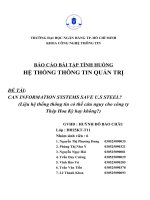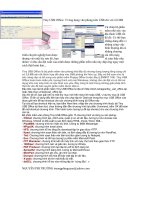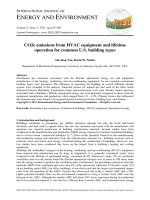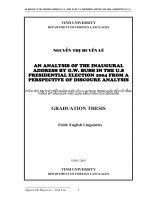Coach U''''s Essential Coaching Tools: Your Complete Practice Resource pot
Bạn đang xem bản rút gọn của tài liệu. Xem và tải ngay bản đầy đủ của tài liệu tại đây (5.24 MB, 542 trang )
o
o
C
ACH
U
o
o
CO
ACH
U
o
ISBN 0 - 47l 711.
72
- 1
".om
"j
Coach
U's Essential
Coaching
Tools:
Your
Complete
Practice
Resource
Coach
U,
Inc.
ffi
WILEY
John
Wiley
& Sons, Inc.
This
hook
is
printed
on
acid-free paper. @
Copyright
© 2005 by
Coach
Inc.
com.
All rights reserved.
Puhlished by
John
Wiley & Sons, Inc.
Hoboken,
New
Jersey.
Published
simultaneously
in
Canada.
No
part
of
this
publication
may be
reproduced,
stored
in a retrieval system,
or
transmitted
in
any
form
or
by any means,
electronic, mechanical,
photocopying,
recording,
scanning,
or
otherwise,
except as
permitted
under
Section 107
or
108
of
the
1976 United States
Copyright
Act,
without
either
the
prior
written
permission
of
the Publisher,
or
authorization
through
payment
of
the
appropriate
per-copy fee
to
the
Copyright
Clearance
Center, Inc., 222
Rosewood
Drive, Danvers, MA 01923,
(978) 750-8400, fax (978) 646-8600,
or
on
the
web
at
www.copyright.com.
Requests
to
the
Publisher for permission should be
addressed
to
the Permissions
Department,
John
Wiley & Sons, Inc.,
111
River Street,
Hoboken,
NJ
07030, (201) 748-6011, fax
(201) 748-6008.
Limit
of
Liability/Disclaimer
of
Warranty:
While
the
publisher
and
author
have used
their
best efforts in
preparing
this
book,
they
make
no
representations
or
warranties
with
respects
to
the
accuracy
or
completeness
of
the
contents
of
this
book
and
specifically disclaim
any
implied
warranties
of
merchantability
or
fitness for a
particular
purpose.
No
warranty
may be created
or
extended
by sales representatives
or
written
sales materials.
The
advice
and
strategies
contained
herein may
not
be suitable
for your
situation.
You
should
consult
with
a professional where
appropriate.
Neither
the
publisher
nor
author
shall be liable
for
any
loss
of
profit
or
any
other
commercial
damages,
including
but
not
limited
to
special, incidental,
consequential,
or
other
damages.
For general
information
on
our
other
products
and
services please
contact
our
Customer
Care
Department
within
the
u.s.
at
(800) 762-2974,
outside
the
United
States
at
(317) 572-3993
or
fax (317) 572-4002.
Wiley also publishes its
books
in a variety
of
electronic formats. Some
content
that
appears
in
may
not
be available
in
electronic books. For more
information
about
Wiley
products,
visit
our
website
at
www.wiley.com.
Designations
used by
companies
to
distinguish
their
products
are
often
claimed as
trademarks.
In all instances where
John
Wiley & Sons, Inc. is aware
of
a claim,
the
product
names
appear
in initial
capital
or
all capital letters. Readers, however, should
contact
the
appropriate
companies
for
more
complete
information
regarding
trademarks
and
registration.
ISBN 0-471-71172-1
Printed in
the
United States
of
America
10
9 8 7 6 5 4 3 2
Contents
Acknowledgments
XI
Preface
Xlli
Introduction
xv
Part 1 Practice Support 1
Chapter 1 About Coaching
and
Being a
Coach
3
1. Client
Q&A
about
Business
and
Personal
Coaching
4
2. Coachee
Q&A
about
Business
and
Personal
Coaching
6
3. Benefits
of
Being a Professional
Coach
9
4. All
about
Coaching: 100 Key Points
about
Coaching
and
the
Coaching
Process
11
5.
Coaching
Customs
14
6.
Primary
Foci
of
Coaching
16
7.
Coaching
Focus Areas
18
8.
The
Professional
Coach
Is
19
9. Basics
of
the
Coaching
Relationship 20
10. Things People
Want
Most
21
11. Coachee Situations 24
12. Should You
Be
a Coach? 27
Chapter 2 About the Prospective Coachee
29
1. Top
Questions
to
Ask a Potential Client 30
2. Potential Coachee Selling
Questions
31
3. Top Sellable Personal Features
of
the
Coaching
Service 33
4. Benefits
of
Working
with
a
Coach
35
5.
Top Five
Objections
Potential Clients Raise 37
6.
Client Lead
Form
39
7.
How
I
Coach
41
8.
How
I
Coach
Clients 43
9.
How
I
Coach
Coachees
44
10.
Coachability Index
45
11.
Complimentary
or
First Session
Agenda
46
12. Referral
Thank
You Letter 48
Chapter 3
For
the New ClientiCoachee
49
1. Agreement
51
2. Credit
Card
Authorization 53
3. Welcome 54
4. Coachee Profile
55
v
Vi
I Contents
5.
How
to
Get
the
Most
Out
of
Your
Coaching
63
6.
Focus
and
Scope
of
Work
67
7.
Client
Data
Sheet
68
8.
Coachee
Data
Sheet 70
9. Welcome
to
Clients 72
10. Welcome
to
Coachees
77
11.
Preparing
for Coaching:
Client
Welcome
Letter
82
12.
Top
10 Ways
to
Get
the
Most
Out
of
Coaching
84
13.
What
to
Talk
about
with
Your
Coach
87
14.
Comprehensive
Assessment
Chart
89
15. Welcome
to
Coaching
90
16.
Coachee
History
91
17. I Believe in You:
The
Coach's
Credo
92
18. Assessment
Summary
93
19.
Goals
List 96
20.
Promise
Log
98
21. Possibility 99
22. Priorities 100
23.
Work,
Career,
or
Business
Environment
101
24.
Money
102
25.
Improvements
to
Make
103
26. 101
Things
to
Work
on
with
Your
Coach
104
27.
Goals
to
Work
on
with
Your
Coach
109
27A. First-Year
Checklist
121
28.
Coaching
Evaluation
122
29.
Evaluation
of
the
Coach
124
Chapter 4 About
Your
Coaching Practice
127
1. 10 Steps
to
Developing a Successful
Coaching
Practice
129
2.
Coaching
Specialties: 100 Areas
of
Specialty
133
3.
Choose
Your
Coaching
Specialties 136
4. Practice Design
138
5.
Client
Extras
141
6. Ideal
Coachee
Characteristics
144
7.
Client
Retention
Checklist 145
8. 25 Steps
to
Filling Your Practice
146
9. 100 Ways
to
Fill Your
Coaching
Practice
148
10.
101+
Ways
to
Fill Your Practice
(and
Keep
It
Full)
151
11.
Team
100
Program
154
12.
Start-up
Budget for a
Coaching
Practice
166
13.
Budget
for
the
First 90 Days
168
14.
Client
Fee
and
Cash
Flow Projection 170
15.
Time
and
Billing
Log
171
16.
Checks
Received
This
Month
172
17.
Cash
Receipts
Log
173
18.
Monthly
Practice
Checklist
174
19.
Top
Five
Things
Your
Coaching
Web Site
Should
Be Set Up
to
Do
176
20. Top Five Ways
to
Convert Your Web Site Visitors
into
Paying
Customers
21.
90+
Ways
to
Use a Virtual Assistant
22. TeleClass Leading: 100 Skills
and
Steps
of
Designing
and
Leading TeleClasses
Contents I
Vll
178
180
189
Chapter 5 About Working with Coachees
193
1.
New
Client Checklist 194
2. Top 10 Places
to
Start
Your
Coaching
195
3.
The
Most
Important
Things
to
Know
about
Your Coachees 198
4.
What
to
Say
to
Your Coachee 201
5.
Coaching
Session Agenda 204
6. First
Coaching
Session 206
7.
Coachee's Life 207
8.
About
the Coachee 208
9. Client Laser Questions:
Creating
Value in
Coaching
209
10. Principles Discussed 210
11.
Coaching
Strategies: 100 Ways
to
Help
Your Coachees
Get
More
of
What
They
Want
211
12. Listen For: 100
Things
a
Coach
Listens For
and
Hears
215
13.
Make
Your Point: 100 Creative
and
Powerful Ways
to
Make
Your Point 218
14. Success Formulas
Program
221
15.
Coaching
Mistakes: 100 Mistakes You
Can
Avoid 229
16.
The
High
Hidden
Costs
of
Coaching
235
17.
Master
Coach
Profile 237
Part
2
Personal
Coaching
245
Chapter 6 Life Coaching
247
1. Skills
to
Work
on
with
a
Coach
248
2. 15
Human
Conditions
250
3. Problems, Concerns,
and
Blocks 251
4. Uncovering
the
Fundamental
Lie 252
5.
Emotional
Reactions:
How
Are You Feeling? 253
6. Reaction Free 256
7.
The
Attachment
Index 258
8. Letting
Go
260
9.
Stress Index 261
10.
The
Adrenaline Lifestyle 262
11. Adrenaline Self-Test 265
12.
Who
Are You? 100 Elements
of
a Person 267
13.
What
Fuels You 269
14. Strengths Inventory 270
15. Personal Wins 273
16.
Resources
and
Assets 274
17. Spending
and
Debt
Questionnaire
275
18. Daily
Report
277
Vlll
I Contents
19.
10
Goals
to
Reach in
the
Next
90 Days 279
20. Clean Sweep
Program
281
21. 25 Secrets
to
Having
the
Life
You
Want
289
22.
The
Success Process: 10 Steps
to
Sustainable, Fulfilling Success
291
Chapter 7
Personal Foundation
293
1. 25 Steps
to
a Strong Personal
Foundation
294
2. Personal
Foundation
Program
295
3. 10 Daily
Habits
306
4. 200+ Tolerations
307
5.
What
Am
I Tolerating? 313
6. NeedLess Program
314
7. Tru Values
Program
321
8.
Reserve Index
Program
328
9.
Super Reserve
Program
335
Chapter 8 Attraction 341
1.
28
Attraction
Principles 342
2.
Fundamental
Changes
to
Becoming Irresistibly Attractive
344
3.
The
Zen
of
Attraction
347
4. Irresistible
Attraction
Program
348
5. 100 Smiles
Program
355
6.
What
Makes
You
Happy?
356
7.
Quality
of
Life 100
363
8.
My
Personal Mission
Statement
367
9. Life
Purpose
Worksheet 368
10. Life Purpose, Business Mission,
and
Legacy 369
11. Personal
Path
Program
370
Chapter 9
Perfect
Life
381
1.
The
12 Areas
of
a Perfect Life
382
2.
The
Zen
of
Perfect
383
3.
The
Benefits
of
Having
a Perfect Life
384
4.
How
to
Have a Perfect Life
385
5.
Background
Changes
to
Make
386
6. "Absence
Of"
100
388
7.
Abundance
Of
392
8.
Time
Peace
Program
393
9. Sports, Recreational Activities,
and
Hobbies
400
10.
My
Perfect Day
402
11. Annual Life Planner
404
12. 100 Steps
to
Becoming a Class Act
405
13. Class Act 100 Program
408
14. Buff
It
Up!
Program
417
Chapter
10
Personal
Evolution
425
1. 100 Ways
to
Know You're Evolving
426
2. 100 Key Distinctions
to
Fully
Understand
and
Evolve Into
431
3.
21
Evolutionary
Practices
4.
Evolutionary
Progressions
5.
Evolutionary
Progressions: 100 Three-Step Developments
6.
Extreme
Self-Care
Program
7. 101 Relationship Questions: Ways
to
Know
You're Evolving
Part 3
Business
Coaching
Contents I
IX
434
436
440
444
452
457
Chapter
11
Business Coaching
459
1.
The
Coach
Approach: An
Introduction
to
Coaching
in the
Organization
460
2.
Coach
Manager/Staff
Excellence
Program
463
3.
Communication
Faults: 100
Communication
Mistakes
People
Make
470
4. Certified
Communicator
Program
473
5.
Biz Whiz Success
Program
477
6. Professional Practice Checklist 485
7.
New
Business
Start-Up
Program
493
8. Business
Mission
Statement
500
9. Business Budget 501
10.
The
Friday Checklist 502
11.
Annual
Goals
Chart
503
12.
Internet
Marketing
100 504
13. Web Site 100: Design
and
Functional
Elements
of
a Terrific Web Site 508
14.
E-Tip
Broadcasting: 100 Steps
to
Setting Up a Successful
E-News
or
E-
Tip
Broadcast
513
Appendix: About the CD-Rom
519
Acknowledgments
In 1992,
the
original
curriculum
for
Coach
U was
authored
by
Thomas
J.
Leonard,
the
person
rec-
ognized as
the
founder
of
the
coaching
profession. Since its
inception,
we have
remained
committed
to
regularly
updating
and
improving
our
materials
to
remain
the
leading
accredited
coach-training
organization
in
the
world.
There
are literally
hundreds
of
seasoned
coaches
to
thank
for
contribut-
ing
to
the
quality
of
our
training
materials.
One
particular
individual
who
deserves recognition is
Jodi
Jan
Shafer,
the
training
director
for
CoachInc.com.
This
book
would
not
have
been
possible
without
her
ongoing
focus
and
dedication.
Each year, we receive
many
calls
and
e-mails
from
our
students
and
graduates,
who
graciously
and
generously
provide
us
with
input
on
how
to
further
improve
our
body
of
knowledge.
Today,
our
materials
truly
embody
the
concept
of
collective
wisdom
at
its very best.
This
book
is a synergistic
product
of
many
minds
coming
together
in
collaboration.
Although
we
cannot
thank
each
contrib-
utor
individually, we sincerely
appreciate
all
of
the
support
that
you have given us
throughout
the
years.
The
comments,
suggestions, class facilitation
and
participation,
and
coaching
experiences
that
you have
shared
with
us have
made
a difference. We
hope
that
you are
proud
of
the
role
that
you have played
and
the
contributions
that
you have
made.
Finally, we
would
like
to
acknowledge
you for
considering
this
book.
We
know
that
if you are read-
ing this
book,
you
have
an
interest in
supporting
others
in
their
personal
and
professional
develop-
ment
or
supporting
the
growth
of
organizations.
Our
vision
has
always
been
to
have all individuals
and
organizations
on
the
planet
take
a
coach
approach
in
all
forms
of
communication,
whether
at
home
or
at
work.
We have
come
a
long
way since 1996,
when
we
started
working
together-there
were fewer
than
500 coaches worldwide. Now,
it
delights us
to
know
that
you,
our
readers,
understand
that
coach-
ing
isn't
found
just
in
sports
and
that
coaching
is
changing
the
world,
one
person
at
a time.
Sandy Vilas
Owner
and
CEO
of
CoachInc.com
Jennifer
Corbin
Coach
U
and
Corporate
Coach
U
President
Xl
Preface
I
began
my
journey
in
the
coaching
profession
in 1989,
when
I
took
a
course
offered by
Thomas
Leonard
and
became certified as a life planner.
Over
the
next
five
years, I
wrote
a
book,
led
workshops,
and
spoke
to
groups
all over
the
country.
During
that
time,
Thomas
started
Coach
U (along
with
being
my
own
personal
coach). I was using
my
coaching
skills
at
every
opportunity,
and
in 1994 I
enrolled
in
Coach
U
and
became
a full-time
coach.
At
that
time,
most
people
had
no
idea
what
coaching
was
or
how
it
worked.
With
the
sup-
port
of
my
coach,
I was
coaching
80
people
a week
at
the
end
of
my
first year.
I was having
more
fun,
was
making
more
money,
and
was
deeply
imbued
with
a sense
of
peace,
fulfillment,
and
satisfaction
that
I
had
never before
experienced.
I
had
clearly
found
my
passion
and
mission in life; or,
rather,
it
found
me
because I
had
done
the
work
and
was ready. Two years
later,
Thomas
was ready
to
sell
Coach
U,
and
a week
later
I
was
the
owner,
amidst
a
great
deal
of
excitement,
mixed
with
a heavy
dose
of
fear.
The
journey
since
has
been
full
of
lessons, satisfac-
tion,
and
joy!
Today we have 27
staff
members
working
out
of
their
homes
in
four
countries,
and
they are
the
most
dedicated,
hard-working,
and
creative
people
I've ever
worked
with.
We have over 100 faculty
members
that
are highly skilled
at
delivering
our
training
and
love giving
back
to
this profession.
We have over
11,000
students
and
graduates
from
51
countries
that
are
making
a difference
one
client
at
a time.
I
attribute
my
success as a
coach
to
excellent
training
in
the
skills,
language,
and
distinctions
avail-
able in
the
book,
as well as
the
brilliant
coaching
I received,
and
as a result I developed a
strong
de-
sire
to
support
others
in
their
success.
One
way
to
realize this
goal
is
to
give
new
coaches
the
benefit
of
not
only
my experience
but
also
the
expertise
of
the
many
coaches,
graduates,
staff
members,
and
faculty
members
of
Coachlnc.com.
Part
of
this is
to
give
our
students
the
many
forms
and
tools
we have developed over
the
years.
There's
no
need
to
reinvent
the
wheel; by
understanding
and
using these
tools
provided,
you will have
the
opportunity
not
only
to
spend
time
on
your
own
self-awareness
and
development
but
also
to
support
your
coachees
in having a
great
life.
As
the
reader
of
this
book,
you are
beginning
your
journey
and
learning
skills
that
will
support
you in
any
endeavor you
choose
to
undertake.
You may be a
professional
manager,
entrepreneur,
or
consultant,
or
you may have a desire
to
become
a full-time
coach.
Whatever
motivation
brought
you
to
this
book,
I
encourage
you
to
immediately
put
the
principles
to
work
in
your
life. I
hope
it
brings you
the
fulfillment so
many
others
have
attained
as a result.
Sandy Vilas
Owner
and
CEO
of
CoachInc.com
Xlll
Introduction
This
book
is designed
to
be a
complete
resources
containing
everything
a
coach
needs
to
begin
and
maintain
a successful
coaching
practice.
These
materials
are
intended
to
make
the
road
to
success
easier so
that
you
don't
have
to
begin
from
scratch
and
reinvent
the
wheel.
Whether
you are devel-
oping
a
coaching
business
or
positioning
yourself as
an
internal
coach,
you will find
materials
to
support
your
success.
Throughout
your
professional
career, you may
encounter
a
coaching
situation
you are
not
sure
how
to
handle.
You may also find
new
and
unfamiliar
challenges
with
your
position
or
in developing
your
business.
This
book
provides resources
that
can
help you
through
these
situations.
You will
often
find
the
just-in-time resource
that
makes
your
work
more
effective.
Our
intention
is
not
that
you
read
this
resource cover
to
cover.
From
time
to
time
you will go directly
to
a specific resource
to
address a
particular
situation.
At
other
times
you will
explore
the
different
areas
and
find
the
resources
that
resonate
with
your
style
and
best
serve
your
coaching
niche.
The
resources are divided
into
three
different types
of
documents:
Forms
Forms are designed
with
open
space
you
can
use
to
record
information.
Forms
for
the
coach
pro-
vide practice
or
position
documentation.
Forms
for
the
coachees
can
provide valuable
information
for
you
and
also give
the
coachee
information
to
refer
to
at
a
later
date.
The
forms
are available in
word
format
on
the
CD-rom
so
you
can
modify
them
to
include
your
personal
coaching
practice
or
position
information.
It
is
not
necessary
to
include
the
Coachlnc.com
attribution
when you
manipulate
the
forms.
Programs
We offer
numerous
programs
that
develop awareness
and
provide
information
to
you
and
your
coachees. Several
programs
are
building
blocks in
handling
major
life
or
business challenges used
in
the
Coachlnc.com
curriculum.
The
programs
are
only
provided
in
format
and
are
not
to
be
altered in any manner.
xv
XVI
I
Introduction
Information
Information
provides key
points
around
which
to
build
the
success
of
your
coaching
practice
or
internal
position,
as
well as
to
support
the
success
of
your
coachees. Based
on
the
collective knowl-
edge
and
experience
of
coaches
worldwide,
they
will provide you
with
valuable tips
and
solutions
for a
wide
variety
of
scenarios.
This
book
is
organized
into
the
following chapters:
1.
About Coaching
and
Being a
Coach
Page 3
This
chapter
will
provide
information
for
both
the
coach
and
the
coachee
on
the
profession
of
coaching.
The
documents
cover
the
profession
in general,
the
coaching
relationship,
and
coaching
focus areas
and
specialties.
Learn
about
the
features
and
benefits
of
coaching,
who
hires a
coach,
customs,
and
foci
along
with
basics
of
the
relationship
and
coachee
situations.
You will find general
and
specific
information,
key
points,
charts,
lists,
and
assessments
to
guide you.
2.
About the Prospective Coachee Page 29
This
chapter
includes
information
on
prospective coachees
and
situations
relating
to
prospects.
Learn
the
questions
to
ask,
the
objections
that
may be raised,
and
the
sellable features
of
coaching.
This
information
will help you
to
be
prepared
when
talking
with
prospects
to
improve your closing
ratio.
Included
are lists
of
questions
to
ask
prospects,
benefits
of
working
with
a
coach,
forms, tips
on
how
and
where
to
find
prospects,
and
an
assessment for prospective coachees.
With
these tools, you
will be well
on
your
way
to
articulating
the
benefits
of
the
coaching
relationship.
3.
For
the New Client /Coachee
Page
49
The
material
in this
chapter
provides all
the
documentation
and
forms
you
can
use
to
start
a new
coachee in a
strong
manner.
It
will
support
you in
the
structure,
administration,
and
processes
for
your
practice,
which
will
promote
the
professionalism
of
your
business.
Both
you
and
your
coachees will have
peace
of
mind
from
the
clarity
the
framework
will provide.
Introduction
I
XVll
Includes are forms for
credit
cards,
coachee
data
and
coachee
direction,
agreements,
letters, infor-
mation,
charts,
questions,
and
evaluations. All these
tools
will get you
off
to
a
strong
start
with
both
your practice
and
your
coachee.
4.
About
Your
Coaching
Practice
Page 127
This
chapter
includes
the
tools
and
strategies for
building
and
sustaining
a successful
coaching
practice.
It
will
support
you
in
adding
value
and
designing a
practice
that
keeps coachees in
your
practice
and
generates referrals.
Information
is
provided
on
creating
web sites, using assistants, fill-
ing
your
practice,
budgeting,
cash
flow,
and
projection,
along
with
TeleClass leading.
The
information,
lists,
forms,
charts,
tracking
sheets,
and
programs
in this
chapter
will give you
tools
and
strategies for success.
From
practice
design
to
client
extras,
you'll
get
the
foundation
you
need for a
strong
start
to
filling
and
maintaining
a base
of
ideal coachees.
5.
About
Worki
ng
with
Coachees
Page 193
This
chapter
will give you a
starting
point
for
working
with
new
coachees. You will
understand
what
to
say,
where
to
start
coaching,
what
to
know
about
your
new
coachee,
how
to
create
value,
what
to
listen for,
and
mistakes
to
avoid.
By
implementing
this
information
you will create value
while developing
the
relationship.
In
addition
to
the
information
provided,
there are checklists,
forms,
and
powerful
questions,
strate-
gies,
and
programs
to
use
with
coachees.
Learning
and
utilizing
the
information
will
support
you
in
working
with
your
coachees
and
support
your
practice
at
the
same
time.
6.
Life
Coach
i
ng
Page 247
This
chapter
provides resources
that
focus
on
supporting
coachees'
personal
development-creat-
ing a life
of
their
dreams,
by design.
The
material
is designed
to
promote
self-exploration
and
bring
awareness
to
who
and
where
your
coachee
is in his
or
her
personal
life.
In this
chapter
you will find
tools
to
learn
about
your
coachee, using assessments, self-examining
questionnaires,
personal
inventories, self-tests,
and
programs
to
work
through.
You
can
also use
these
tools
for
your
own
personal
growth
or
to
further
your
own
development.
Working
through
these
materials
takes
time
and
commitment.
XVlll
I
Introduction
7.
Personal
Foundation
Page 293
Your
personal
foundation
is
much
like
the
foundation
of
a building.
The
deeper
and
stronger
the
foundation,
the
taller
the
structure
can
be
built.
You
want
your
coachees
to
build a
strong
founda-
tion
for
their
lives in
order
to
have lives
of
authenticity, which are aligned
with
their
values,
and
to
have
their
needs
met,
once
and
for all.
With
a
strong
personal
foundation,
your
coachees will be
able
to
deal
with
life
on
life's terms.
This
chapter
includes list
of
information,
tracking
forms,
and
in-depth
programs
that
will strengthen
your
coachees'
foundation.
It
is designed
to
walk
them
through
the
core
structure
that
forms the
base
from
where they live
their
lives.
8. Attraction Page 341
This
chapter
covers
the
laws
of
attraction.
You
attract
that
which you
put
out
to
the
universe.
The
concept
of
attraction
is
to
naturally
pull
things
toward
you
rather
then
pushing
them
toward
you-
in
other
words,
floating
downstream
instead
of
fighting
the
current.
Applying these concepts, you
will
struggle
less
and
life will
become
effortless. You
and
your
coachees will benefit
tremendously
from
becoming
attractive.
Included
in this
chapter
are
the
main
principles
of
attraction,
changes
to
make, step-by-step pro-
grams,
enhancement
programs,
and
purpose
worksheets.
9.
Perfect
Life
Page 381
In this
chapter
we will
explore
the
concept
of
having a
perfect
life.
Can
this be
done?
We
believe
so.
This
is
about
your
coachee
taking
his
or
her
life
to
the
next
level
and
creating
the
life he
or
she
truly
desires.
By
taking
everything
up
a
notch,
your
coachees will raise
the
bar
on
the
quality
of
their
lives.
You will find
information
on
improving
and
perfecting
their
lives
along
with
concepts
and
pro-
grams
that
will
enhance
their
development
in this area.
By
implementing
the
concepts
presented
they
can
dramatically
improve
their
lives.
10.
Personal
Evolution
Page 425
This
chapter
will
continue
your
coachees'
personal
evolution
and
take
everything they have
learned
up
to
this
point
to
the
next
level.
It
will
continue
their
growth
and
development
as individuals.
Introduction
I
XiX
Included
is
information
that
defines evolving, explores ways
to
evolve,
and
explains
how
to
know
you are evolving.
There
are lists, assessments,
and
programs
to
support
the
coachee
in this
contin-
ued growth.
11.
Business
Coaching Page
459
This
chapter
targets
the
business
world
from
sole
proprietors
to
corporations
and
includes infor-
mation,
forms,
and
programs
relating
to
businesses
or
organizations.
They
can
be used for
your
client's business
or
internal
coaches
within
corporations.
Not
all
information
will be applicable
to
all
situations;
however,
you
can
adapt
it
to
suit
your
needs.
The
information
is laid
out
so
that
it provides
introductory
material,
programs
to
work
through
for skill awareness
and
growth,
and
business forms,
tracking
sheets,
and
checklists
to
use.
Many
of
these forms
can
be
passed
on
to
your
coachees
to
use.
Please feel free
to
forward
your
questions
or
comments
to
me
at
Jodi
Jan
Shafer,
Master
Certified
Coach
Training
director,
CoachInc.com
About Coaching
and
Being a
Coach
This
chapter
is designed
to
provide
information
for
both
the
coach
and
the
coachee
on
the
profes-
sion.
It
will provide
information
on
the
profession
in
general,
the
coaching
relationships, focus
areas
and
specialties.
Learn
about
what
coaching
is,
the
benefits
of
coaching,
who
hires a coach,
customs,
and
foci
along
with
basics
of
the
relationship
and
coachee
situations.
You will find general
and
specific
information,
key
points,
charts,
lists,
and
assessments
to
guide
you.
The
following sections are included in this chapter:
1.
Client
Q&A
about
Business
and
Personal
Coaching
2.
Coachee
Q&A
about
Business
and
Personal
Coaching
3. Benefits
of
Being a Professional
Coach
4. All
about
Coaching: 100 Key Points
about
Coaching
and
the
Coaching
Process
5.
Coaching
Customs
6.
Primary
Foci
of
Coaching
7.
Coaching
Focus Areas
8.
The
Professional
Coach
Is
9. Basics
of
the
Coaching
Relationship
10.
Things
People
Want
Most
11.
Coachee
Situations
12.
Should
You
Be
a
Coach?
3
What is coaching?
Coaching is a new profession that has synthesized the best from psychology, business, evolution,
philosophy, spirituality, and finance to benefit the entrepreneur, professional, and business owner.
Why does coaching work?
Coaching works because of three unique features:
Synergy: Client and coach become a team, focusing on the client’s goals and needs
to accomplish more than the client would alone.
Structure: With a coach, a client takes more action, thinks bigger, and gets the job
done, thanks to the accountability the coach provides.
Expertise: The coach knows how to help entrepreneurs make more money, make
better decisions, set the best goals, and restructure their professional and personal
lives for maximum productivity.
Who works with a coach?
Entrepreneurs, business owners, professionals, and people in transition use a coach to fix, solve,
create, or plan something, personally or professionally.
What is worked on?
Here is what the client and coach work on together:
Business planning, budgeting, and goal setting
Integrating business and personal life for balance
Turning around a difficult situation
Achieving maximum work performance
Handling business or personal problems
Making key decisions and designing strategies
Prioritizing actions and projects
Catching up and getting ahead of the business
Increasing sales substantially or filling a practice
Client Q&A about Business
and Personal Coaching
Copyright © 2005 by Coach U. Inc. www.coachu.com.
But how does a coach do this?
Coaching is delivered during regular, weekly sessions by telephone or in person whichever is more
convenient. Clients bring an agenda of items to the call or meeting. The coach helps them solve
problems and make the most of opportunities. When they are taking on a large goal, we help them
design the project and provide the support and structure needed to make sure it gets done. We bring
out each client’s best by offering advice, expecting a lot, helping them strategize and celebrating
their wins. A practice can be national, with clients in every area of the country, from big cities to
small towns; clients can range from small business owners to CEOs; and coaching can focus on
either business goals or personal goals.
What should I look for in a coach?
The right coach brings out your best, consistently. To do this, the coach you select should pass the
following three tests: (1) Does this coach have a track record of helping someone like me accom-
plish the goals I want? (2) Do I feel good and motivated to act when with this coach? (3) Will this
coach keep up with me—and stay ahead of me—as I grow? That’s it. You can always check refer-
ences and try out the coach for a month to see if he or she is really the right one for you. I work
well with three types of clients: (1) entrepreneurs and small-office professionals who are smart,
quick, and ready to do what it takes to reach blockbuster goals; (2) individuals who are making
substantial changes in their personal and professional lives; and (3) individuals who are working
on an important project.
How much does it cost?
The fee for most entrepreneur and professional clients ranges from $200 to $500 per month for a
weekly meeting or coaching call. For example, monthly coaching fees may be $250 for a weekly half-
hour call or $500 for a weekly one-hour call, using an 800 number. There are no other charges, and
clients may call in between calls for additional assistance, if needed. For projects, they may be billed
at $125 per hour. For presentations, facilitating, or training, the fee is $1,500 per day, plus expenses.
How would I get started?
If you feel that this type of relationship could work for you, call and let’s talk. Coaching is not
something we sell; it is something you buy because you want it.
Where do I start with a coach?
Most coaches begin with a special client meeting to get to know each other. The coach wants to
hear about the client’s goals, needs, and problems. The client wants to get comfortable with the
coach. During this meeting, both parties design a list of goals and a game plan to reach these goals.
Prior to this meeting, the client will have received a welcome package containing checklists and
assessment materials to make the most of the meeting. Some coaches spend extra time (gratis)
with new clients getting to know them and coaching them to set the best goals for themselves, and
together they design the best way to work together as a team to accomplish the goals.
Copyright © 2005 by Coach U. Inc. www.coachu.com.
What is coaching?
Coaching is a new profession that has synthesized the best from psychology, business, evolution,
philosophy, spirituality, and finance to benefit the entrepreneur, professional, and business owner.
Why does coaching work?
Coaching works because of three unique features:
Synergy: Coachee and coach become a team, focusing on the coachee’s goals and
needs to accomplish more than the coachee would alone.
Structure: With a coach, a coachee takes more action, thinks bigger, and gets the
job done, thanks to the accountability the coach provides.
Expertise: The coach knows how to help entrepreneurs make more money, make
better decisions, set the best goals, and restructure their professional and personal
lives for maximum productivity.
Who works with a coach?
Entrepreneurs, business owners, professionals, and people in transition use a coach to fix, solve,
create, or plan something, personally or professionally.
What is worked on?
Here is what the coachee and coach work on together:
Business planning, budgeting, and goal setting
Integrating business and personal life for balance
Turning around a difficult situation
Achieving maximum work performance
Handling business or personal problems
Making key decisions and designing strategies
Coachee Q&A about
Business and
Personal Coaching
Copyright © 2005 by Coach U. Inc. www.coachu.com.
Prioritizing actions and projects
Catching up and getting ahead of the business
Increasing sales substantially or filling a practice
But how does a coach do this?
Coaching is delivered during regular, weekly sessions by telephone or in person whichever is more
convenient. Coaches bring an agenda of items to the call or meeting. The coach helps them solve
problems and make the most of opportunities. When they are taking on a large goal, we help them
design the project and provide the support and structure needed to make sure it gets done. We bring
out each coachee’s best by offering advice, expecting a lot, helping them strategize and celebrating
their wins. A practice can be national, with coachees in every area of the country, from big cities to
small towns; coachees can range from small business owners to CEOs; and coaching can focus on
either business goals or personal goals.
What should I look for in a coach?
The right coach brings out your best, consistently. To do this, the coach you select should pass the
following three tests: (1) Does this coach have a track record of helping someone like me accom-
plish the goals I want? (2) Do I feel good and motivated to act when with this coach? (3) Will this
coach keep up with me—and stay ahead of me—as I grow? That’s it. You can always check refer-
ences and try out the coach for a month to see if he or she is really the right one for you. I work
well with three types of coachees: (1) entrepreneurs and small-office professionals who are smart,
quick, and ready to do what it takes to reach blockbuster goals; (2) individuals who are making
substantial changes in their personal and professional lives; and (3) individuals who are working
on an important project.
How much does it cost?
The fee for most entrepreneur and professional coachees ranges from $200 to $500 per month for
a weekly meeting or coaching call. For example, monthly coaching fees may be $250 for a weekly
half-hour call or $500 for a weekly one-hour call, using an 800 number. There are no other charges
and coachees may call in between calls for additional assistance, if needed. For projects, they may
be billed at $125 per hour. For presentations, facilitating, or training, the fee is $1,500 per day, plus
expenses.
How would I get started?
If you feel that this type of relationship could work for you, call and let’s talk. Coaching is not
something we sell; it is something you buy because you want it.
Copyright © 2005 by Coach U. Inc. www.coachu.com.
Where do I start with a coach?
Most coaches begin with a special coachee meeting to get to know each other. The coach wants to
hear about the coachee’s goals, needs, and problems. The coachee wants to get comfortable with
the coach. During this meeting, both parties design a list of goals and a game plan to reach these
goals. Prior to this meeting, the coachee will have received a welcome package containing checklists
and assessment materials to make the most of the meeting. Some coaches spend extra time (gratis)
with new coachees getting to know them and coaching them to set the best goals for themselves,
and together they design the best way to work together as a team to accomplish the goals.
Copyright © 2005 by Coach U. Inc. www.coachu.com.
The professional coach benefits in six special ways, given the level of commitment it takes to be-
come one. This article describes these benefits unique to our profession.
Benefit #1: You double your rate of
personal development.
One of the fastest ways for a person to grow is to coach others. When you are accountable for re-
sults, share distinctions, and give advice, you learn, learn, and learn. In fact, you’ll learn 80 percent
of what you need to know directly from your clients. (A mentor coach or coach-training program
gives you the critical 20 percent, but you should consider your clients as your real trainers. You
spend a lot of time with them and learn much about yourself in the process.)
Benefit #2: You can make an extraordinary living.
Coaches earn between $25,000 and $200,000 per year. A few earn even more. Hourly fees range
from $25 to $225. It takes a lot of training and experience to earn the higher numbers. After about
five years, you can start making that kind of money if you are extraordinary, if you attract entre-
preneurial or corporate clients, and if coaching is the right profession for you. If $50,000 a year is
the right income for you, that can take between one and three years to reach.
The point is that with proper training, having the gift of coaching, and being part of a strong net-
work, coaching can be a well-paying profession.
Benefit #3: You build close friendships and empowering
relationships that will last a lifetime.
People who coach and clients who want to be coached are special people because they understand
and value the power of synergy and partnership. They are at a place in life where being a lone
ranger is not effective and not fun.
There is nothing wrong or unethical with having a client be your friend, assuming both of you
are up to it. Clients become your partners in life, because they are contributing to you just as you
Benefits of Being a
Professional Coach
Copyright © 2005 by Coach U. Inc. www.coachu.com.
are contributing to them. (Be careful, though; some clients need all the focus on them right now,
particularly if they are going through a transition or challenging time. Be selective.) Notice that
new clients usually are preoccupied with themselves and their issues. If a friendship occurs, it will
develop over time.
Benefit #4: You become a master of life.
A full-time coach is on a path of development that leads to mastery. If you’ve learned the distinc-
tions of coaching, managed a full practice for several years, and taken care of your own life accord-
ingly, chances are you’ll be extraordinary. (Having clients and keeping them straight and in integrity
will send you to the funny farm if you don’t honor yourself and your life accordingly.)
Benefit #5: You are well positioned for the
next opportunity.
Some coaches are built to coach for a lifetime. Others love the profession but will move on after
four or five years. The profession is full of opportunities—many of which are not yet revealed.
The skills you learn, the growth you experience, and the great group of people you meet (colleagues,
clients, and friends) set you up to notice, participate in, and benefit from opportunities such as:
Pursuing new business opportunities
Getting involved in national issues
Writing, speaking, and more
Benefit #6: You get to give your gift.
We all have a special gift—a set of skills, a unique ability, a natural passion. Most coaches have a
strong desire to empower others and contribute to them. Being a professional coach gives you li-
cense to do just that, full-time; what could be better? And you learn how to share your gift without
hurting, depleting, or costing you—while you make a living.
Benefit #7: You will be appreciated.
Coaching another person is a contribution—and many clients will love you for it. Coaches shouldn’t
coach to get love, but you will get it. So enjoy!
Copyright © 2005 by Coach U. Inc. www.coachu.com.









